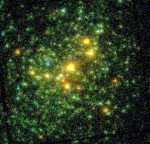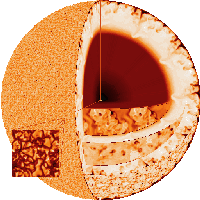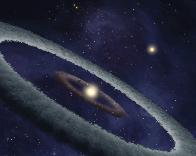Contact: Pr. Gregor Rauw
Institut d'Astroph. et de Géoph.
Université de Liège
Quartier Agora
Allée du 6 août, 19c - Bât. B5c
B-4000 Liège (Sart-Tilman)
Belgique
What are the projects linked to this telescope?
This telescope concentrates on the study of the main components of the Universe, i.e. the stars. In Liège several groups of the AGO Department are thus concerned.

The GAPHE (Groupe d'Astrophysique de Haute Energie), leader of the project, takes advantage of the telescope to deepen its studies on massive stars. The latter objects, at least ten times more massive than the Sun, play an essential role in the synthesis and dissemination of chemical elements (oxygen, nitrogen, carbon, iron,...) which are essential to the formation of planets and life as we know it. These massive stars are also able to trigger the birth of other stars, to shape the interstellar medium, to ionize their surroundings and create beautiful nebulae: they are really the queens of the galaxies! Despite their strategic importance, these objects are unfortunately not very well known and this is where HRT-el TIGRE can play an important role: it enables GAPHE to not only perform detailed studies of their variability, but also to analyze massive couples in order to accurately determine their fundamental physical parameters (masses, sizes, distances,...).

The ASTA group (Astrophysique Stellaire Théorique et Astéroséismologie) uses the HRT-el TIGRE to study the properties of pulsating stars, whose surface continuously vibrates, such as a drum skin. Similarly to musical instruments, the frequencies and the amplitude of these oscillations depend on the properties of the star: a small bell and a large bell, or a wooden bell and a bronze bell do not deliver identical sounds! The ASTA researches thus obtain interesting information on the physical properties of the star under study, as well as on its internal structure, which is otherwise inaccessible due to the fact that the light remitted by the stars only comes from a thin superficial layer.

In partnership with GAPHE, other astrophysicists of the departement study massive stars at the end of their lives, the so-called LBVs (Luminous Blue Variables). These rare objects (about a dozen known in our galaxy) make it possible to get knowledge on an instable, crucial, albeit very short, phase of the lives of massive stars. Yet other researchers of Liège try to detect spectral particularities of young stars surrounded by protoplanetary debris disks: there exist in the vicinity of young stars some boulders and/or icy structures which, when they aggregate, will lead to the formation of planets. However all the matter is not necessarily used and the remains can form a debris disk. Such a thick layer of ice + dust makes the study of these stars quite uneasy: they thus tend to remain poorly known. The high resolution of the spectrograph attached to the telescope will deliver more information on the close environment of these young stars. This makes it possible to better understand how stars and planets are formed, and in particular how our solar system was formed.
In total, several tens of astrophysicists from Liège have been and are involved in projects linked to el TIGRE. It is worth mentioning that the principal collaborator of the Liège astronomers at the University of Guanajuato is Pr Philippe Eenens ... an alumnus from Liège University!
Images (c) GAPHE, NASA, Nordlund



